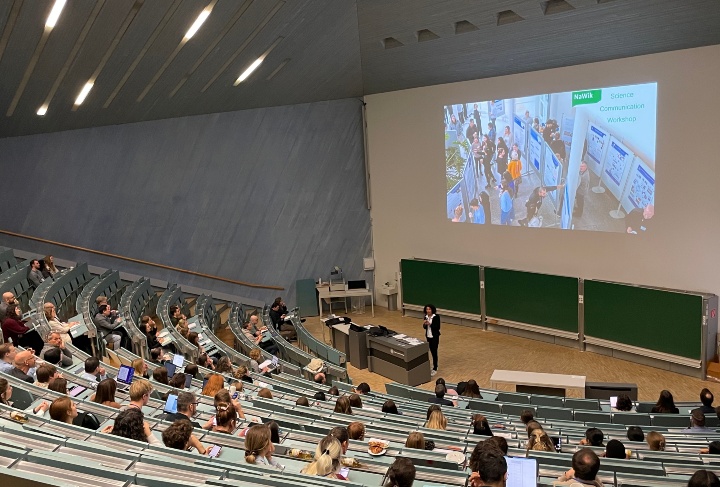Approximately 200 biomedical researchers participated in the annual 3R-Network Baden-Württemberg conference held from April 1st to 2nd. This year, the conference was organized by the 3R-BioMedicUS research network at the University of Stuttgart. The event focused on innovative patient models that offer alternatives to animal testing and advance biomedical research.
The 3R principle - "Replace, Reduce, Refine" - aims to minimize and improve animal testing by replacing and reducing the use of animals while improving the conditions of indispensable studies. Within the Baden-Württemberg 3R-Network, universities and research institutions with diverse biomedical specializations collaborate to advance this objective. They are supported by the Baden-Württemberg Ministry of Science, Research and the Arts (MWK).
In 2025, the network expanded once again with the addition of three new centers in Karlsruhe, Furtwangen, and Ulm. In early April, both new and longstanding network partners gathered at the University of Stuttgart for a two-day conference. The annual meeting was organized by the 3R-BioMedicUS research network at the University of Stuttgart.
New Patient Models: Significant Advancements in Research
The presentations and poster sessions focused on patient models that not only provide the framework for more animal-friendly research, but also benefit humans. “The aim is to develop alternative patient models that reflect complex human biology much more precisely than has been possible to date,” says University of Stuttgart´s 3R-BioMedicUS spokesperson Professor Monilola Olayioye from the Institute of Cell Biology and Immunology. "This contributes to a deeper understanding of diseases and the optimization of medications and treatment strategies."
At the annual conference, experts from all over Baden-Württemberg discussed innovative methods for new patient models on three levels: Ex vivo, de novo and in silico. “Ex vivo” refers to tests that are carried out on living tissue, but outside the body, i.e. in a test tube or Petri dish. In the “de novo” method, the tissue is recreated from biological building blocks - for example using a 3D printing process. “In silico” means experiments using computer models.
“De novo” highlight: research into animal-free adipose tissue models
Among the approximately 20 conference speakers was Prof. Petra Kluger, who will assume a professorship at the Institute of Institute of Interfacial Process Engineering and Plasma Technology at the University of Stuttgart in June. In her keynote presentation, Prof. Petra Kluger introduced her specialized field of research, namely adipose tissue engineering, which focuses on cultivating cell-containing 3D adipose tissue in the laboratory. “Adipose tissue is much more than just a “cushion”. It produces and transports a large number of signaling substances and therefore plays an important role in metabolic processes and the immune system,” says Kluger. However, there are still many unanswered questions about the structure and function of adipose tissue.
Through her research, Kluger aims to bring clarity to previously unexplored areas. At Reutlingen University, she has been developing high-precision 3D models of healthy adipose tissue for years. More recently, she has successfully created models that simulate inflamed adipose tissue. These models, which are still rare, help to better understand chronic diseases such as obesity, diabetes or Crohn's disease. The models can be produced within a few days and deliver results quickly. Another special feature is that the models consistently do without animal components. "We work with human primary cells. Our nutrient solutions for cell cultures are defined and therefore free of animal components such as serum. The hydrogels for 3D culture also consist of animal-free biological Gellan, which is obtained from bacteria. This allows us to replace traditional animal ingredients such as collagen or gelatine and work in a truly animal-free way.”
3R-BioMedicUS at the University of Stuttgart: Expanding its reach
“We are delighted that Petra Kluger will be joining the 3R-BioMedicUS research network at the University of Stuttgart in June. Her expertise in adipose tissue research is a valuable addition to our portfolio," says Prof. Monilola Olayioye. To date, 3R-BioMedicUS has addressed topics ranging from cancer therapy and artificial blood vessels to digital simulations of neurophysiological processes. 3R-BioMedicUS was recently successfully evaluated by the Baden-Württemberg Ministry of Science, Research and the Arts (MWK). "With the renewed funding approval, we can establish 3R-BioMedicUS as a permanent institution at the University of Stuttgart," says Olayioye with enthusiasm.

About 3R-BioMedicUS and the 3R-Network BW
The 3R-BioMedicUS research network at the University of Stuttgart focuses on developing predictive patient models and innovative therapeutic strategies, while also integrating the 3R principle - Replace, Reduce, Refine - into both research and education. 3R-BioMedicUS has a broad technical and methodological base. The state-of-the-art laboratory infrastructure includes a multiphoton microscope, which can also be used to generate high-resolution 3D images of deep tissue layers.
3R-BioMedicUS works closely with partner centers in Tübingen, Heidelberg, Mannheim, Constance, Karlsruhe, Furtwangen and Ulm, which are united in the 3RNetwork Baden-Württemberg. The Baden-Württemberg Ministry of Science, Research and the Arts (MWK) promotes the network, scientific exchange and joint teaching opportunities.
Contact

Lena Jauernig
Editor Research / Early Career Researchers




